Key Insights into Construction Management Evolution
- Spreadsheet Limitations: Manual data entry, version control nightmares, and siloed information lead to costly errors and slow decision-making in construction.
- Real-time Visibility: Integrated platforms like Archdesk provide dynamic dashboards, offering immediate insights into project financials and progress, enabling proactive adjustments.
- Enhanced Collaboration: A single source of truth connects office and site teams, streamlining communication, document management, and RFI processes, reducing delays and miscommunications.
Let's be honest, for ages, spreadsheets have been the trusty sidekick for so many construction companies. Whether you’re tracking bids, managing budgets, or just trying to get a handle on timelines, Excel, or maybe Google Sheets, has probably been your go-to. It feels familiar, like an old friend, doesn't it? And for a while, it totally worked. It’s a bit like that reliable old pickup truck; it gets the job done, even if it’s a bit rusty and needs a lot of gas. But, much like that truck on a big cross-country haul, spreadsheets eventually hit their limits when things get complex.
The "Before": A Tangled Web of Data
When Spreadsheets Take Over Your Construction Life
Picture this scenario: You’re a construction executive, trying to get a quick, accurate snapshot of project profitability. What happens next? Someone on your team is likely scrambling, pulling data from half a dozen different Excel files. They're manually typing in numbers, praying they don't hit the wrong key. Honestly, it's a bit like building a house with a tape measure that stretches and shrinks on its own, making every measurement a gamble. One tiny typo, and your entire forecast could be off, causing a ripple effect across the whole project, leading to unexpected costs down the line.
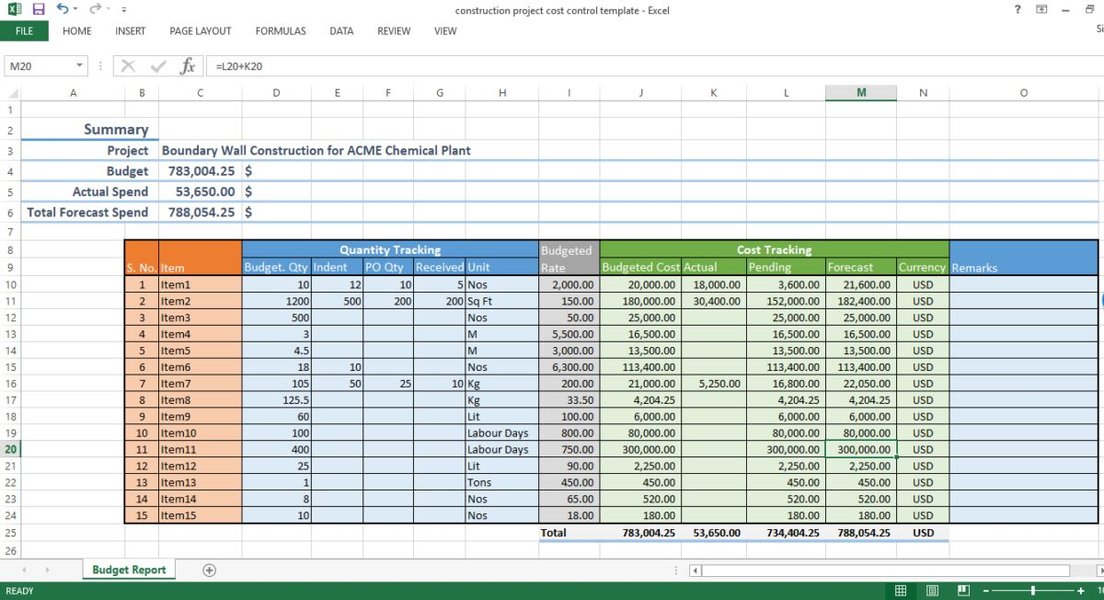
Manual tracking in spreadsheets can lead to fragmented data and inefficiencies.
The Persistent Problem of Manual Data Entry
Those late nights poring over rows of data? We've all been there. Manual processes aren't just time-consuming; they're incredibly prone to error. Research suggests a significant chance of errors when you're manually punching numbers into spreadsheets, and that risk skyrockets with complex files. Think about it: basing your company’s financial health on those kinds of odds is, well, a bit unsettling. Plus, there’s the sheer amount of time spent updating figures, trying to reconcile data at month-end, and deciphering someone else's intricate spreadsheet. That’s precious time you could be spending strategizing for future bids, or, you know, actually building things.
Siloed Information and Communication Gaps
When your data lives in separate spreadsheets, it creates these little islands of information. The estimating team has their files, procurement has theirs, and accounting has theirs. Nobody's truly working from the same playbook. This often leads to miscommunication, delays, and unexpected costs. It’s like trying to conduct an orchestra when half the musicians are reading from different scores – it’s just not going to sound harmonious, is it? RFIs get lost in email chains, project changes aren't updated across all relevant documents, and version control becomes a constant headache. That email chain with the final_FINAL_budget_v3.xlsx attachment? We've all been there.
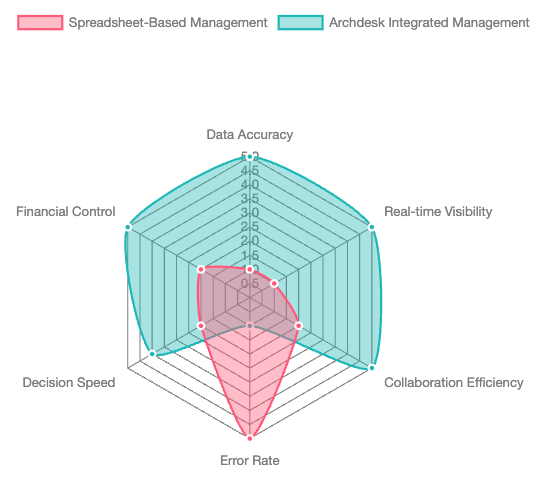
This radar chart illustrates the stark difference in performance between traditional spreadsheet management and an integrated system like Archdesk across several key metrics. Higher scores are better for Data Accuracy, Real-time Visibility, Collaboration Efficiency, Decision Speed, and Financial Control, while lower scores are better for Error Rate.
The "After": Embracing Clarity with Archdesk
Trading the Old Pickup for a Brand-New System
So, what happens when you decide to ditch those spreadsheet nightmares and embrace a purpose-built solution like Archdesk? It’s a bit like trading in that old, rusty pickup for a brand-new, integrated construction management system. Suddenly, everything just… works. Those fragmented data islands become one clear, cohesive picture. All your project information—from bidding and estimation to procurement, scheduling, and financials—lives in a single, cloud-based platform. This means real-time data, always. No more waiting for yesterday’s numbers to catch up; you see what’s happening right now.
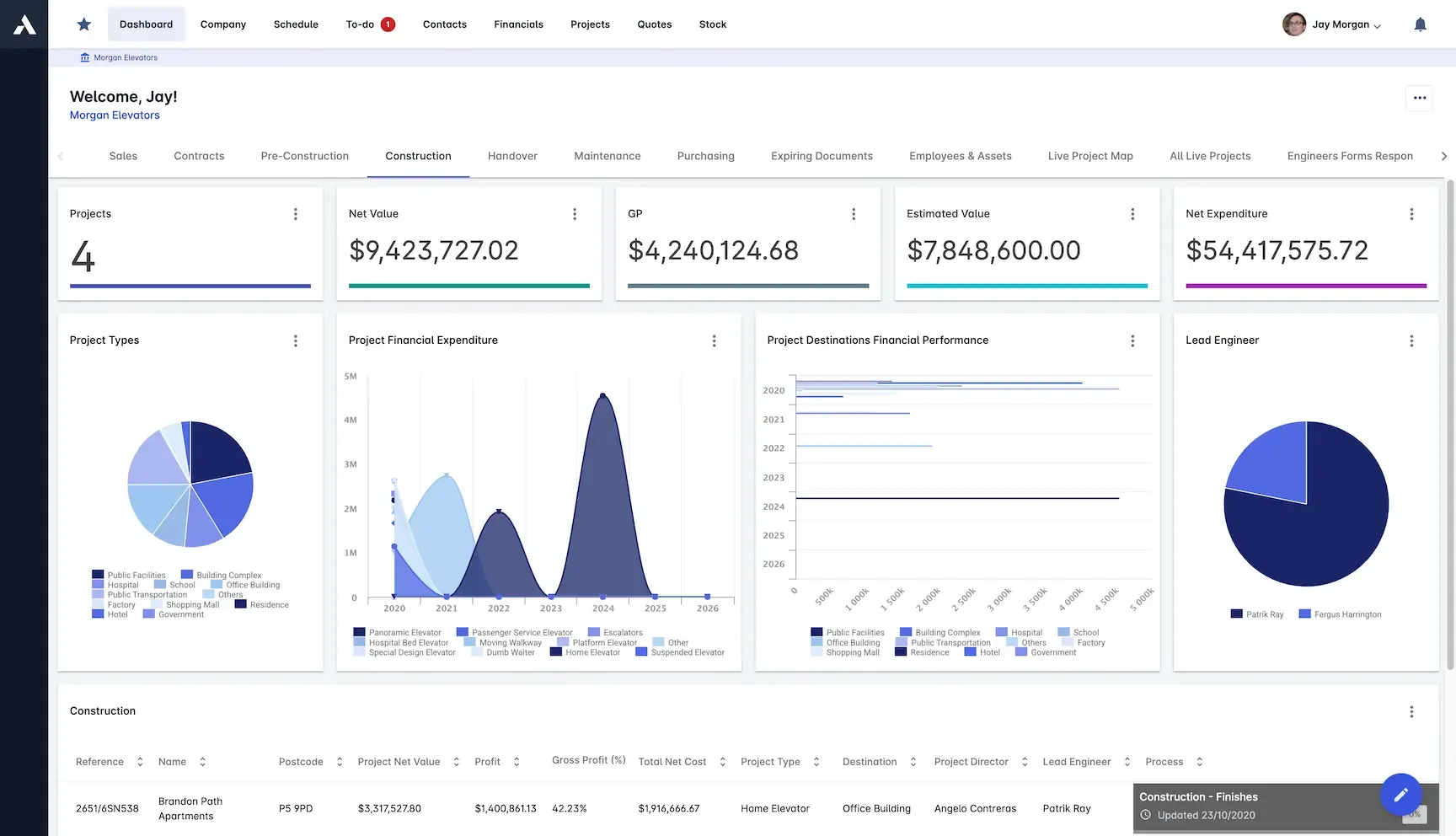
Archdesk provides a centralized platform for managing all aspects of construction projects.
Dynamic Financial Control and Cost Awareness
Instead of static spreadsheets, you get dynamic dashboards that show your project’s financial health in real time. You can see estimated costs versus actual costs the moment they’re logged on-site. This means you can spot a potential budget drift early and course-correct before it becomes a crisis. For example, Archdesk provides a clear Cost Breakdown Structure, showing exactly where your money is going. This kind of visibility allows you to make data-driven decisions and react quickly to any changes, instead of being surprised by unforeseen expenses when it's too late. That's not just efficiency; it's financial control.
Seamless Estimation and Procurement
Remember those manual data entry errors? Gone. Archdesk automates repetitive processes, ensuring accuracy and freeing up your team for more strategic work. Estimating becomes much sharper because the platform connects all the processes, providing revisions to created estimates automatically. You can build the estimate in Archdesk, and it instantly becomes your Bill of Quantities (BOQ), budget, and procurement plan. No rework, no copy-pasting. Revisions are tracked, and markups are clear. And if you still love Excel for certain analyses, you can import and export cleanly without breaking your structure.
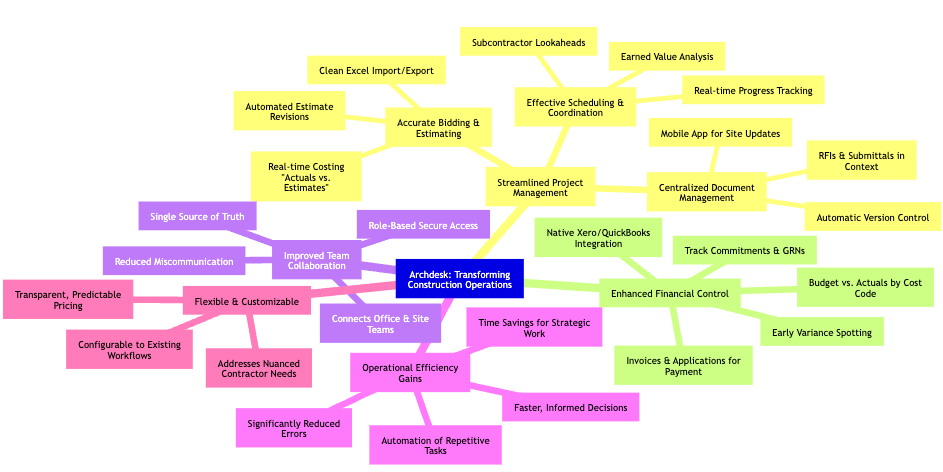
This mindmap illustrates how Archdesk acts as a comprehensive solution, integrating various aspects of construction management into a unified platform. It highlights the key features and benefits that streamline operations, improve financial oversight, and enhance collaboration.
Enhanced Collaboration and Communication
Collaboration also gets a massive boost. With everyone accessing the same up-to-date information, communication roadblocks often disappear. Your field teams can upload reports directly from the site using a mobile app, and you get that data instantly. This is crucial for things like RFI management, where delays can cost serious time and money. Archdesk even has pre-loaded RFI templates to make that process smoother. Imagine all your documents, from specifications to change orders, managed securely in one place, fostering better collaboration between the office and the site.
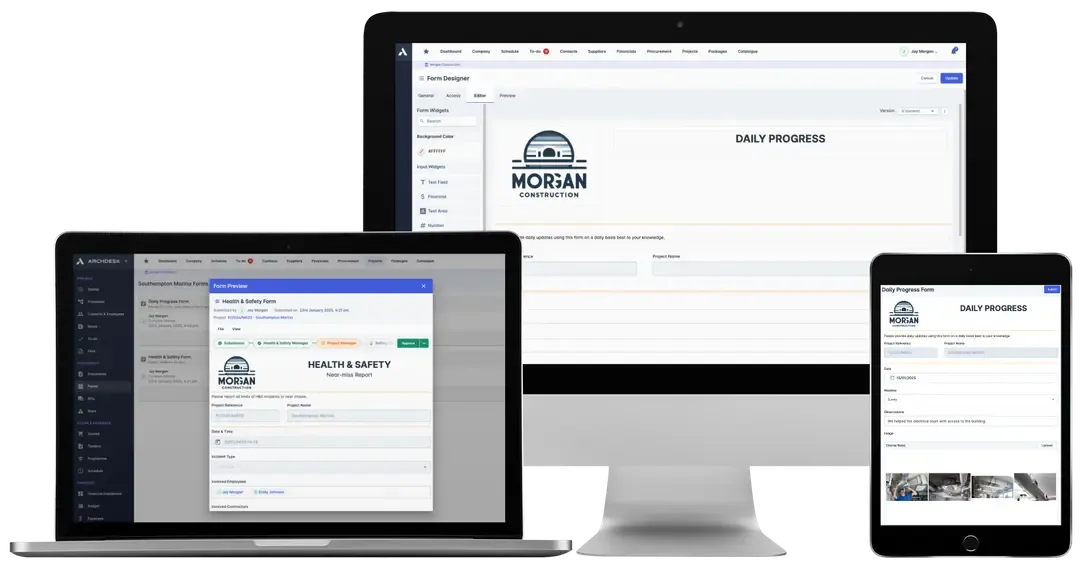
Mobile forms and site data collection are simplified with Archdesk, bridging the gap between office and field.
Beyond Just Efficiency: Real Control
Beyond just efficiency, Archdesk gives you a level of control that spreadsheets simply can’t match. You can track actual versus estimated costs with detailed budget breakdowns, easily analyze your financial situation, and manage all financial activities from one platform. This helps you forecast job costs accurately and create profitable project budgets. For instance, companies like City Diamond Contracting have seen enhanced project and financial management and advanced procurement tracking after adopting Archdesk. It’s not just about managing projects; it’s about managing your entire company's financial stability.
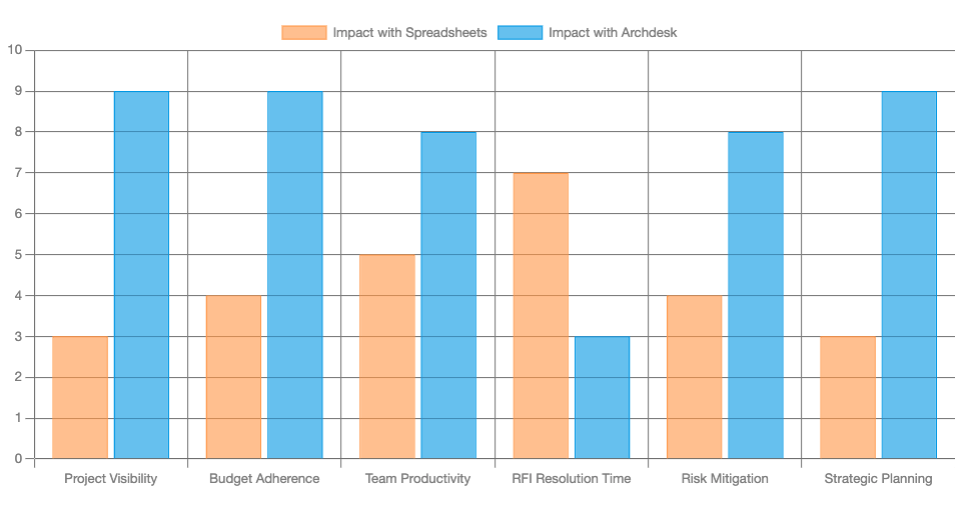
This bar chart compares the measurable improvements in various operational areas after transitioning from spreadsheet-based methods to Archdesk. Lower values are better for RFI Resolution Time, while higher values indicate better performance in other categories.
Change Management Simplified
Variations move from request to approval to budget impact in a straight line. Stakeholders see cost and time effects before they commit. This means fewer surprises and certainly fewer uncomfortable calls. Archdesk is built to support every stage of a project, from bidding to handover, making it a robust, cloud-based ERP solution explicitly designed for construction companies. While you might hear names like Procore or Autodesk Construction Cloud, Archdesk distinguishes itself with predictable pricing and customizable workflows, giving businesses tailored financial control without the bloat.
Making the Switch: Practical Steps
Smooth Sailing, Not Scary Seas
The idea of moving to a new system can feel daunting. You might worry about the learning curve or disrupting your team’s workflow. But think of it this way: you’re not adding more work; you’re centralizing it. Implementing Archdesk is about building a single source of truth. Instead of forcing your processes to fit the rigid rows and columns of a spreadsheet, Archdesk molds itself around your existing workflows. A dedicated specialist from your team works with Archdesk to configure the platform, ensuring it fits like a glove from day one.
Tips for a Successful Rollout
The initial setup does require some effort, sure, but it pays off massively. You’re not just uploading data; you’re building a new operational backbone for your company. Here are some practical tips to make the transition smooth:
First, pick an internal champion. Give them time, not just a title, to lead the charge. Second, start with one project and a lean Work Breakdown Structure (WBS). Prove the flow there, then scale. Third, map your cost codes to accounting early; it saves a ton of headaches later. Finally, you can certainly keep Excel for ad hoc analysis if you must, but always keep your master data in Archdesk. It’s an investment, but one that pays off in increased efficiency, reduced errors, and ultimately, a healthier bottom line. Think of it as investing in a sturdy, modern foundation for your business – something every construction professional can appreciate.
The Bottom Line: Building Smarter
Why You Can't Afford to Stay in the Past
Replacing spreadsheets with Archdesk isn’t about chasing a trend. It’s about choosing a simpler, more reliable way to run your business. It’s about replacing guesswork with certainty and frustration with clarity. The hours you used to spend reconciling spreadsheets can now be spent on what actually matters: analyzing trends, strategizing for future bids, and leading your team. You’re managing the business, not just managing the data.
You didn’t get into construction to be a data entry clerk, did you? You got into it to build things. It’s time your software helped you do just that. If you’re tired of reconciling yesterday’s spreadsheets, move the work into Archdesk and let the numbers meet you where you are—on site, in the office, or somewhere on the motorway between both.
Here’s a quick overview of how traditional methods stack up against a modern solution like Archdesk:
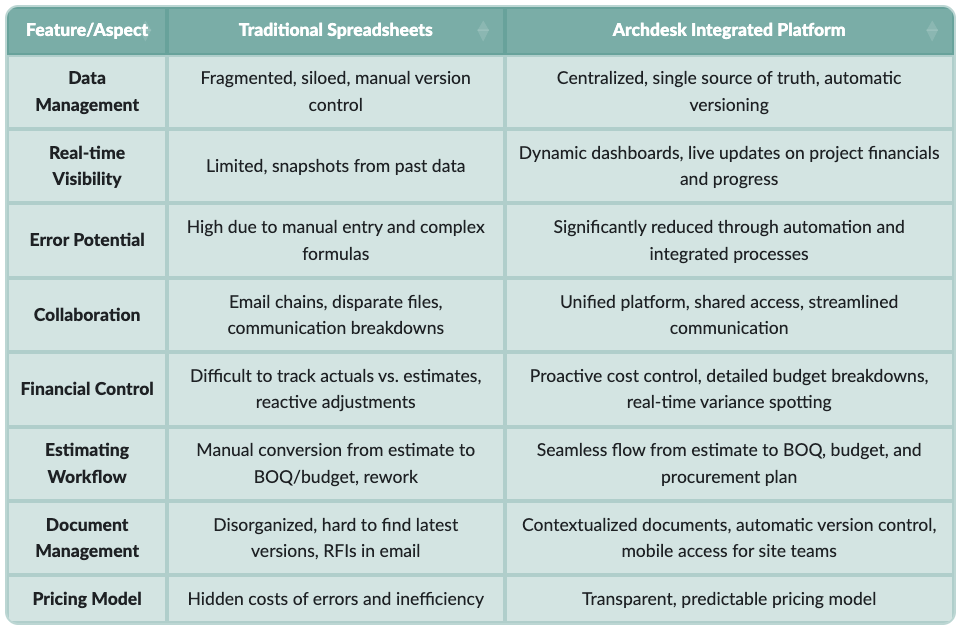
Frequently Asked Questions
What are the main problems with using spreadsheets in construction?
Spreadsheets lead to fragmented data, high error rates from manual input, version control nightmares, slow decision-making due to outdated information, and poor collaboration because data is siloed across different files and teams.
How does Archdesk improve financial management in construction projects?
Archdesk provides real-time visibility into project finances with dynamic dashboards, allowing you to track actual costs against estimated budgets instantly. It helps spot variances early, manage commitments, and integrate with accounting systems like Xero or QuickBooks, ensuring better financial control and accurate forecasting.
Is it difficult to switch from spreadsheets to a new system like Archdesk?
While there's always an adjustment with any new system, Archdesk is designed with an intuitive interface and offers dedicated implementation support. The process is about centralizing your operations rather than adding complexity, ultimately leading to smoother workflows once adopted.
Can Archdesk replace other construction software I might be using?
Archdesk aims to be an all-in-one platform, consolidating features often found in separate tools. While it competes with larger platforms like Procore or Autodesk Construction Cloud, Archdesk offers customizable workflows and predictable pricing, often proving to be a more tailored fit for the nuanced needs of many contractors.
What specific benefits do field teams get from using Archdesk?
Field teams can use mobile apps to upload daily reports, log progress, and manage documents directly from the site. This instantly updates project information for office teams, streamlines RFI management, and improves overall site-to-office communication.
References
Archdesk Blog: Ditch the Spreadsheets
Archdesk Blog: Construction Estimation
What's the best construction management software platform that isn't ...
The 12 Best Construction Accounting Software in 2025 | Archdesk Blog
Construction risk management: How to make your projects more ...
The 11 Best Construction Reporting Software Tools in 2025 | Archdesk Blog
Customer Projects | Archdesk Community
15 Best Construction Project Management Software Tools in 2025 | Archdesk Blog





